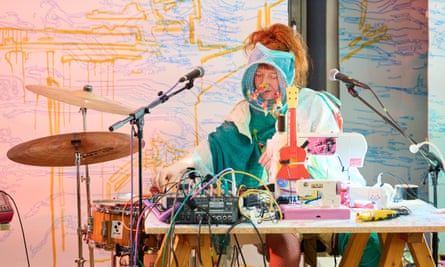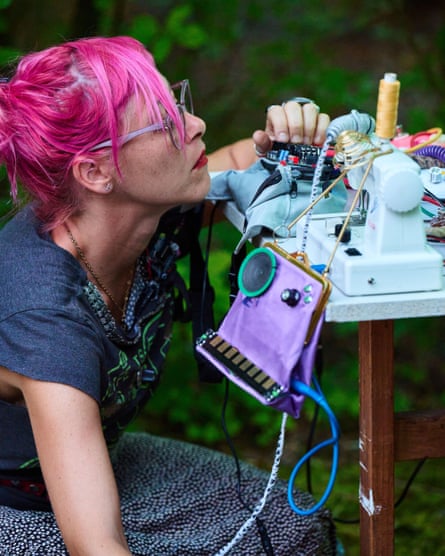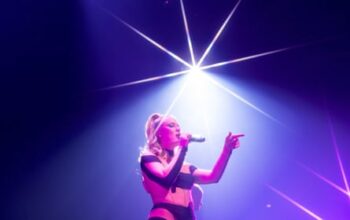Stepping into the studio of the Brazilian-born artist and performer Lisa Simpson – no relation to the cartoon character – feels like entering a crossover between the Mad Hatter’s workshop and a postindustrial steampunk landscape with a colourful girl-power twist. The ground floor space in Berlin’s southern district of Neukölln is filled with shelves laden with old sewing machines and coat racks brimming with hats, bags and fabric scraps. Even more sewing machines propped on two tables might suggest that this is a tailor’s workshop, were it not for the tangle of cables and synthesisers connected to them. Toy sewing machines in candy colours have a purple phone receiver attached; colourful cables with knitted covers sneak out of household sewing machines and seam overlockers; pins and needles are connected to microphones.
Some of Simpson’s sewing machines really are used for sewing, but most of them are living a second life as musical instruments. Having spent years teaching herself basic engineering, she is converting them to synthesiser-like devices for live performance. “It started with toy sewing machines,” she says. “I always thought they were so pretty – but they were impractical for actual sewing. So I started putting oscillators and sensors inside them to use them for sound-making. Then a few years ago, I started putting electronics into a household sewing machine and it has become a sort of synthesiser.”
Together with the Munich-based artists Stephanie Müller and Klaus Erika Dietl, Simpson has founded a loose collective of like-minded sewing machine musicians, Ensemble Dressed in Sound. Their largest undertaking takes place this weekend: Sharper Than a Needle, the world’s premier “textile machine orchestra”, will perform on Sunday at Munich’s Kammerspiele theatre, just an hour after polling stations close for Germany’s snap election.

It promises to be an anarchic happening somewhere between a pop concert, a community sewing party and experimental theatre. The project was born out of Müller’s and Simpson’s shared love for sewing as an artistic and musical practice. “It’s funny, we both started to make music with sewing machines around 2004, but we didn’t know each other yet,” Müller tells me in a video call. Ten years later, during an artistic intervention programme in Munich, she and Simpson were introduced and quickly started performing together as a sewing machine duet. “At first, we only had the basic sewing machines we used at home and parts of a drum set with us on stage,” she says. Soon after founding their partnershop, Müller invited her frequent collaborator Dietl to join. Originally a painter, he also works with haberdashery as a tool for sound making – for instance, amplifying the sound of threading a needle.
A concert in the city of Görlitz proved a turning point: “It was soon after we started collaborating,” says Müller. The AfD [far-right party Alternative für Deutschland] was already very established there and we weren’t sure about how the audience would react to us.” They not only loved it – they joined the performers on stage. “They were so interested in what we did and wanted to take a closer look,” says Müller. Some asked if they could have a go themselves; others had clothing in need of small repairs. What was intended to be a performance became a communal happening. “There was no division between stage and audience any more.”

Since then, this open format became a trademark of their events. “We usually have an extra machine with us in case anyone wants to join spontaneously,” says Müller. They also invite the audience to bring along any clothes in need of attention. But Müller does not see their performances existing in any kind of experimental art silo: to her, it’s pop music devoid of hierarchies. “And sewing is similar, people of all different ages and backgrounds have access to it,” she adds.
This performance with the sewing machine orchestra is the largest project they have undertaken so far – around 20 performers will be on stage, working with sewing machines, scissors and needles, spinning wheels, knitting machines and anything in between. Performers such as wheelchair dancer Sema Schäffer and dancer and percussionist Ángela Muñoz Martínez will be wearing costumes that change and transform throughout the performance. “They will come to the sewing machine,” Simpson explains, “and some parts of their costumes will be sewn on stage, so it will be like we are dancing together.”
The project also weaves in politics: Simpson and Müller explain that, to them, their performances are an expression of feminist empowerment, putting an often devalued form of labour into a different context. (They have repeatedly experienced seeing their expertise questioned by male sound engineers at venues). Plus, highlighting and recontextualising the skill of sewing is also intended as a thoughtful critique of the contemporary fashion landscape. “I have always loved fashion,” says Müller. “I totally get why people love to consume clothes! But I am also interested in the exploitative side of fashion and its mechanisms of exclusion through sizes and standardisation.”
Joy and criticism, sewing and sound making, pop performance and clothing repairs – Müller, Simpson and their collaborators are making an ecstatic Gesamtkunstwerk, one stitch at a time.
Source: theguardian.com


